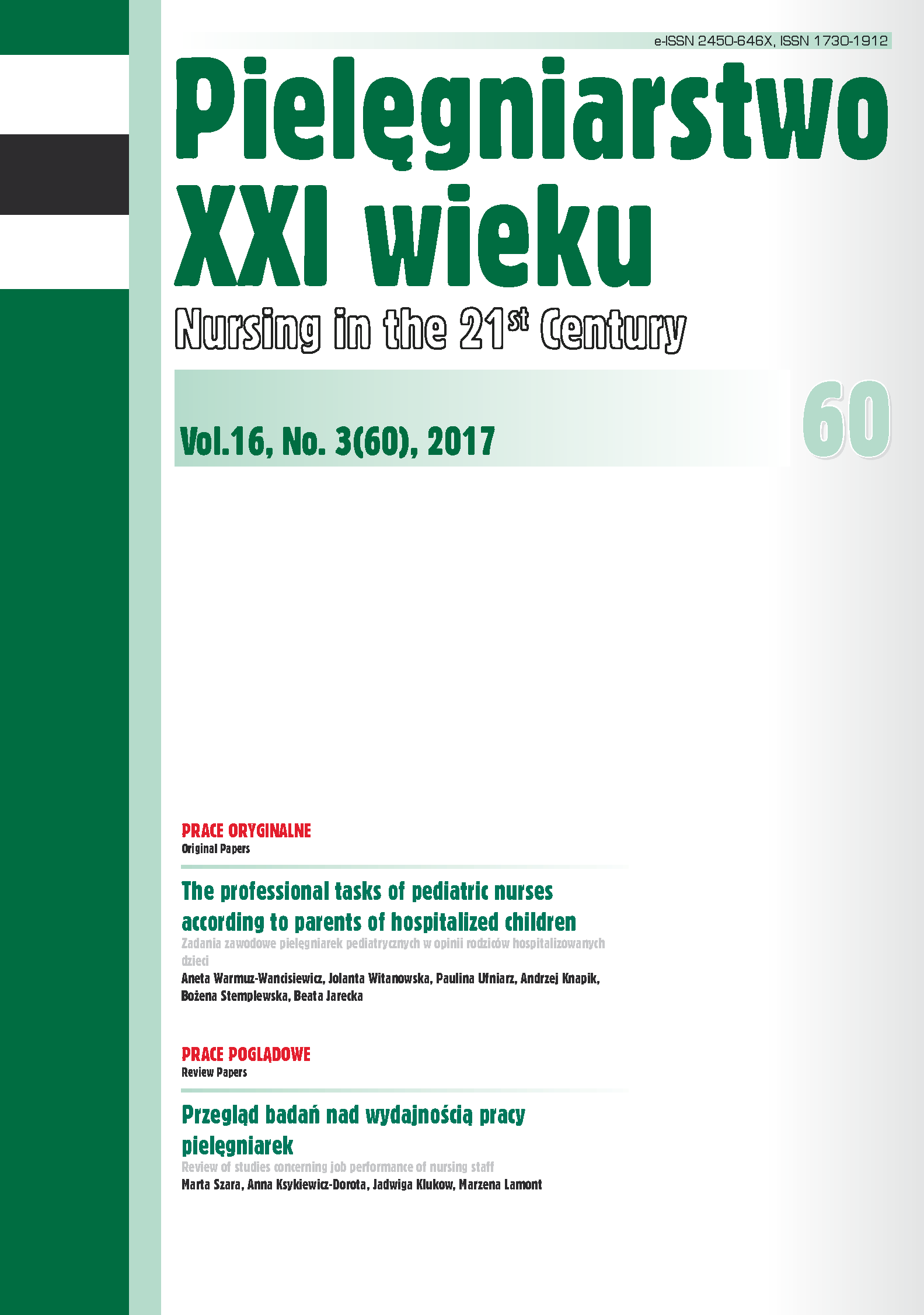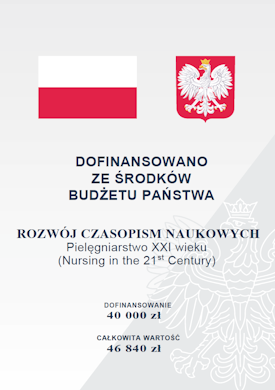Actions improving the image of a nurse in electronic media. Opinion of medical students
DOI:
https://doi.org/10.1515/pielxxiw-2017-0027Keywords:
professional image, electronic media, nursing students, Polish nurses, improving the imageAbstract
ACTIONS IMPROVING THE IMAGE OF A NURSE IN ELECTRONIC MEDIA. OPINION OF MEDICAL STUDENTS
Aim. The aim of study was to define actions improving the image of nurses in electronic media.
Material and method. 219 women and 44 men took part in a survey. They were the students of the following courses: nursing, medical rescue, obstetrics, medicine, dentistry, pharmaceutics, physiotherapy, public health. The studies were undertaken with use of own questionnaire in 2015.
Results. Majority of respondents 64,6% (n=169) stated that improvement of image of their own profession belongs to the nurses, and only 35,4% (n=93) respondents indicated that the professional organizations of nurses and midwives have their impact on it. According to the students, the most crucial action that should be undertaken by professional organizations in order to improve the image of profession in electronic media was the improvement of wages and working conditions (72,2%, n=189) and better promotion of the profession in electronic media (73,8%, n=193). The nurses can influence the improvement of their image in media by taking care of the good opinion about the profession by setting good example (32%, n=84), and also by creating blogs, social forum, online information services, etc. (26,2%, n=69).
Conclusions. According to the respondents, the image of a nurse in electronic media is shaped by the television and radio. The mentioned media tend to present nursing environment in a negative light. The data analysis shows that according to the respondents, the professional organizations of nurses and midwives and nurses themselves should be responsible for improvement of the situation. In order to improve the image, the nurses should promote professional achievements, change the stereotype used in shows and movies, and familiarize the public with the profession. The following branches of mass media should be used: internet websites, television and radio.
References
1. Dyczewski L. Więź rodzinna a media elektroniczne. Ruch Prawniczy, ekonomiczny i socjologiczny. 2005; LXVII(1): 231, 235.
2. Lemish D. Dzieci i telewizja. Perspektywa globalna. Wydawnictwo Uniwersytetu Jagiellońskiego; 2008.
3. Miller G, Galantem E, Pribram K. Plans and the structure of behavior. New York Holt, 1980 12.
4. Grabska K, Stefańska W. Sylwetka zawodowa pielęgniarki w opinii pacjentów. Problemy Pielęgniarstwa. 2009; 17(1): 8-12.
5. Centrum Badania Opinii Społecznej: Opinia społeczna na temat badania zaufania publicznego. http://www.cbos.pl/SPISKOM.POL/2016/K_018_16.PDF (dostęp: 2017.05.27).
6. http://www.gallup.com/poll/1654/honesty-ethics-professions.aspx (dostęp: 2017.05.27).
7. Lepa A. Opinia publiczna, media i zasady etyki. Paedagogia Christiana. 2011; 1(27): 90-93.
8. Dobek-Ostrowska B. Media masowe w systemie demokratycznym. Dolnośląska Szkoła Wyższa Edukacji Towarzystwa Wiedzy Powszechnej, 2003.
9. Konwencja o Ochronie Praw Człowieka i Podstawowych Wolności sporządzona w Rzymie dnia 4 listopada 1950 r., zmieniona następnie Protokołami nr 3, 5 i 8 oraz uzupełniona Protokołem nr 2. Dz.U. z 1993 r. nr 61, poz. 284.
10. Prawo prasowe. Dz.U. z 1984 r. nr 5, poz. 24. Ustawa z dnia 26 stycznia 1984 r.
11. Sobczak M, Kamińska B. Poziom prestiżu zawodowego pielęgniarek w opinii wybranych grup. Problemy Pielęgniarstwa. 2012; 20(2): 218–222.
12. Kołodziej A. Czynniki określające status społeczny pielęgniarek. Hygeia Public Health. 2014; 49(1): 69-74.
13. Grychtoł S, Leszczyńska K. Stereotypy a pozycja zawodowa. Magazyn Pielęgniarki i Położnej. 2012; 10: 4-5.
14. Kunecka D. Jak Cię widzą tak Cię piszą. Magazyn Pielęgniarki i Położnej. 2011; 10: 4-5.
15. Sykut A. Media elektroniczne w budowaniu wizerunku zawodowego pielęgniarek. Opinia pielęgniarek czynnych zawodowo. Nieopublikowana praca magisterska napisana pod kierunkiem B. Dobrowolskiej.
16. Januszewicz P, Zarzycka D, Binkowska-Bury M, Marć M, Zalewska K. Pielęgniarki i lekarze – życie codzienne i prognozy na przyszłość. Przegląd Lekarski. 2009; 66(7): 469-470.
17. Dahnke M, Dreher M. Philosophy of Science for Nursing Practice, Second Edition: Concepts and Application. New York: Springer Publishing Company; 2016.
Published
Issue
Section
License
Copyright (c) 2017 Authors

This work is licensed under a Creative Commons Attribution-NonCommercial-NoDerivatives 3.0 Unported License.




